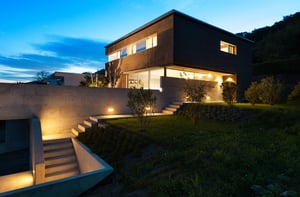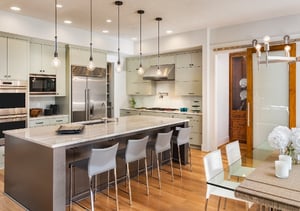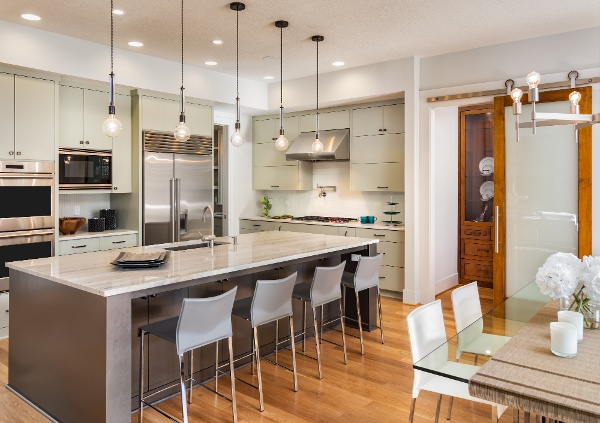
Home lighting automation can improve your sleep schedule.
You don’t need to be a rocket scientist to understand the importance of a good night’s sleep. Who hasn’t stared...
 One of the many great features of a smart home is that it gives you elevated control over your lighting. Smart homes can control both natural and electric lighting, using local switches, web user interface, and occupancy sensors and presets. Controlled lighting saves energy and thus reduces costs in unoccupied spaces.
One of the many great features of a smart home is that it gives you elevated control over your lighting. Smart homes can control both natural and electric lighting, using local switches, web user interface, and occupancy sensors and presets. Controlled lighting saves energy and thus reduces costs in unoccupied spaces.
Smart controls are ideal for setting up lighting scenes. These scenes can be controlled from switches, calendar, or in response to an event. Create a romantic atmosphere, dim the lights automatically when the TV comes on, or use automatic lighting to scare away to potential burglars.
As well as these practical (and fun!) uses, smart control lighting can actually benefit your wellbeing and health. Here’s how.
A research paper published in 2011 by Jens Christoffersen identified that ‘what is quite certain is that lighting environments have a direct influence on the health and well-being of the people living and working in them’.
 The key to understanding the relation between lighting and health is understanding circadian rhythms. The National Sleep Foundation provides this definition:
The key to understanding the relation between lighting and health is understanding circadian rhythms. The National Sleep Foundation provides this definition:
‘Your circadian rhythm is basically a 24-hour internal clock that is running in the background of your brain and cycles between sleepiness and alertness at regular intervals. It's also known as your sleep/wake cycle.’
Christoffersen states that the variation of light is ‘by far the most important factor in setting and maintaining our natural daily rhythm, the so-called circadian rhythm’.
The setting and maintaining of this daily rhythm is extremely important if you want to be alert and healthy. The National Sleep Foundation point out that ‘your circadian rhythm works best when you have regular sleep habits, like going to bed at night and waking up in the morning around the same times from day to day’. Disruptions to your circadian rhythm can make you feel out of sorts and can make it harder to pay attention.
Everyone feels the effects when they miss out on sleep. Impaired concentration and increased irritation are often noted after a late night out. But a lack of sleep can have serious long-term consequences. According to the NHS, regular poor sleep ‘puts you at risk of serious medical conditions, including obesity, heart disease and diabetes – and it shortens your life expectancy’.
But how can smart lighting help you get a good night’s sleep?
Well, alongside circadian rhythms, it’s also important to understand the role of the hormone melatonin.
The NIH (National Institutes of Health) describes melatonin and its function thus [PDF]:
‘Melatonin is a natural hormone that plays a role in sleep. Melatonin production and release in the brain is related to time of day, rising in the evening and falling in the morning. Light at night blocks its production’.
Simply put, melatonin is what makes you feel sleepy. It’s released when it gets dark. If you want to stay lively and get to sleep when you need to, you want to have light during the day, and darkness in the night.
It’s clear from understanding circadian rhythms that regularity and routine is extremely important. Using smart controls, you can set up automatic lighting that complements your daily routine and provides a consistency that works in harmony with your circadian rhythms.
Or you can set up lighting scenes that operate with your melatonin production in mind. For example, you can set the lights to automatically dim at 10pm to help you start feeling sleepy. For those who need a more emphatic reminder to switch off and go to sleep, you could set the lights to automatically turn off at 11pm.
 Smart lighting can also come in handy in the middle of the night. You can set up automatic lighting pathways to lead the way to the bathroom (or kitchen!), or set lights to a low dimness so that you’re not blinded by the glare of a bright light.
Smart lighting can also come in handy in the middle of the night. You can set up automatic lighting pathways to lead the way to the bathroom (or kitchen!), or set lights to a low dimness so that you’re not blinded by the glare of a bright light.
Smart controls could even help SAD sufferers. The NHS website recommends that those with SAD should make their ‘work and home environments as light and airy as possible’. In a smart home, you can set up automatic ventilation and lighting to ensure that your home is fresh and bright, and remotely controlled blinds make it easy to let the sun in.
It’s plain to see that smart controls have abundant uses when it comes to lighting, and as detailed here they can even work in tandem with your sleep cycle. In a smart home your lighting does it all: it’s fun, practical, automatic, energy-saving and even good for your health!

Smart devices are on the rise. A recent report by YouGov found that nearly a quarter of British people own more than one smart home device. The most popular device is...